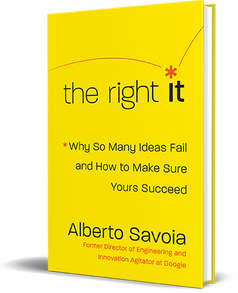Five Questions for Alberto Savoia, A Man On A Mission To Prevent Failures Among Entrepreneurs7/7/2019  Suppose you come up with an idea and fall in love with it so much that you decide to create a business around it, and then discover that there is no market for your product or service. You will have wasted a lot of time and money. So what could have done to prevent this from happening? You could have prototyped it or—even better--pretotyped it. Pretotype is a virtual prototype, meaning that you first test your idea to determine if there is a market for your product or service before you make an effort to develop it. This concept was popularized by Alberto Savoia, and he teaches this in his excellent book Right It: Why So Many Ideas Fail and How to Make Sure Yours Succeed in which he teaches how anyone can pretotype a product, service or just about anything. Alberto taught the power of pretotyping to students at Stanford and also made the ideas available as a free book. In fact, he practices what he preaches. He wrote in his pretotype book that "I wrote and 'edited' it in days instead of months, just to test the level of interest in such a book." After seeing the success of his free book, he enhanced the book and published it. I highly recommend you read this book and start using the ideas taught in the book. Pretotyping, as Alberto likes to say, will allow you to “test ideas fast like a Lamborghini and cheap like a Fiat.” And he is right. I used pretotyping to see if it was worth spending time developing a workshop. I sent a flyer to those who had attended talks I had given on job interviewing. Soon I discovered that only a handful of attendees were willing to pay for the workshop. Based on that information, I converted the workshop into two coaching sessions for those who signed up to attend the workshop. Pretotyping saved me a lot of time and money in developing a workshop when there were not enough customers willing to pay for it. I became a believer in this powerful concept and wanted to get this message out about pretotype, and I was happy that Alberto took time to answer five questions I posed to him. I want to thank Alberto for his mission to reduce failures among entrepreneurs with the talks he gives, videos he posts on YouTube and the book he published. It is one of the most practical books you will ever read and most importantly become a believer like me in this concept. If you would like to learn more about Alberto Savoia, please check out his website albertosavoia.com. Here are two talks that Alberto gave that you will find very useful: The talk he gave at Stanford’s Entrepreneurial Thought Leaders -- eCorner https://ecorner.stanford.edu/video/build-the-right-it-entire-talk/ The talk he gave at the Lean Product & Lean UX Silicon Valley MeetUp https://www.youtube.com/watch?v=EPUu8_EXiNg Alberto is an outstanding speaker since he knows how to present actionable information in an entertaining way. Alberto also has made excellent video lessons related to his book Right It that is available on YouTube: https://www.youtube.com/channel/UCzgbutZja0Vs-U7NcrDj42g Question 1: Aren’t some things hard to pretotype since customers may lack the imagination on how it can make their life better? I am specifically thinking about the famous quote by Henry Ford that “If I had asked people what they wanted, they would have said faster horses.” This admittedly famous quote is just that, a famous quote. Let me tell you a few of the things that are wrong about it: 1) Ford said, “If I had asked people ...” so he never actually asked. He never collected the data and just assumed. I don’t need to tell you why that is bad. 2) He would have asked a question. Not only that but a hypothetical one. If you’ve read the book, you know how much trust one should put in such questions. 3) There is no skin in the game involved, so all Ford would get back (if he bothered to ask) would be opinions. See my book for my opinion on opinions. 4) The quote implies a universal quantifier (i.e., people == ALL people). What do you think are the odds of EVERY SINGLE PERSON answering the same way? I’d say 0%. I bet some people fed up with horses would have welcomed the idea of a horseless carriage. I could go on, but you get the drift. I discuss all this in detail in the chapters about Thoughtland and Hocus Pocus Focus Groups. Some people lack imagination. Some have a surplus of imagination—those are the ones who come up with crazy ideas. That’s why you PRETOTYPE, you take your idea down from Thoughtland and don’t ask people what they want, show them something you’ve thought up to see if they are interested enough to put in some skin in the game. Like Elon Musk did with the initial Tesla Roadster. Ford got lucky with the car, but how many such stories of visionary ideas end up in failure? Most of them. So it’s not smart to cherry-pick your examples and decide based on them. Question 2: Who should do pretotyping? People inside the company or outside the company? And if inside, who is best skilled to do this? Marketing? Sales? Engineering? It depends on the organizations. Some companies want to do it in-house. Others hire external help (e.g., www.exponentially.com) to help them stay objective. There’s no right answer—or wrong answer. Pretotyping is a set of tools (imagine a toolbox with hammers, screwdrivers, levels, etc.), the tools simply work, what you do with them and who uses them is up to you. Question 3: Can pretotyping provide the wrong information in that it will tell you that there is a potential market, but not big enough for it to ever become a successful business? No market research tool can accurately predict the size of future markets. That’s why the XYZ Hypothesis is phrased as “At least X% of Y will do Z.” Most companies that become giants are themselves surprised by their own success. But pretotyping can give you, with better confidence and accuracy than most other Thoughtland approaches an estimate of the current market size. Question 4: Have you ever run into a situation where pretotyping prevented one from building a product that later became successful by somebody else? How do you prevent this from happening? You are asking if pretotyping can give you a false negative. It has never happened to me or my teams/clients. But I suppose it could happen in some rare cases—especially if you don’t practice pretotyping correctly. Even the quadratic formula will give you the wrong result if you mess it up. But think about this: How many products expected to succeed actually fail? This should be your primary concern. Further, no two products or teams or situations are the same. There are always differences, big and small. People who said, “I had that idea” or “they stole my idea” are often crying sour grapes. And those ideas are similar to theirs but not the same ... and the actual products built and marketed by one team is never the same as the actual product built and marketed from a different team. Question 5: Isn’t sometimes the only way to really know whether your product is a “wrong it” is by getting it to the market? For example, you point out that New Coke was the “wrong it.” But Coke did what you would call pretotyping before they released the New Coke. According to my understanding, Coke was losing market share to Pepsi, especially to the younger generation since they liked its sweet cola taste. The only way Coke could fail was by getting the New Coke into the market. When people started buying it, they didn’t want the Coke to change since they could get a sweeter cola in Pepsi. Coca Cola (and most such companies) based their decision on focus groups and taste tests. It was mostly hypothetical and in Thoughtland. Coke’s big mistake was to go big (i.e., national campaign, big launch all over the US, taking old Coke off the shelves, etc.) They should have tested it on a much, much, MUCH smaller scale. They should have hypozoomed first and expanded later. Bonus Question: I see a lot of people taking courses to get a better job. But do you think before they do that, they should create a pretotype resume to determine what skills will make them marketable before they spend a lot of time and money taking courses or getting certifications? That’s VERY funny because I was discussing this very topic with a friend. He was planning to pay a few $K for a data science course to add to his resume, and I told him he should do an A/B experiment. Beginning with a (modified) XYZ Hypothesis: If I add “Data Science Certification” to my resume, I will get 10% more interview opportunities. Then, say, send out two copies of his resume (one with the certification and one without) to a bunch of companies and see which one gets more responses/requests for interviews, etc. Of course, you need to find a way to do this ethically, but it can be done. Five Book Recommendations Skin In The Game: Hidden Asymmetries in Daily Life, by Naseem Taleb Antifragile: Things That Gain from Disorder by Naseem Taleb Fooled by Randomness: The Hidden Role of Chance in Life and in the Markets by Naseem Taleb Thinking, Fast and Slow by Daniel Kahneman Loonshots: How to Nurture the Crazy Ideas That Win Wars, Cure Diseases and Transform Industries by Safi Bahcall #####  Jay Oza is a writer, speaker, executive coach. He makes people thrive on high stakes stage whether it's for a job interview, a sales presentation or an important speech. He is the author of the book Winning Speech Moments: How to Achieve Your Objective with Anyone, Anytime, Anywhere. Please download the speech checklist and the speech workbook to help you with your next high stakes speech. Please contact him if you would like to attend his workshop or invite him to have it at your site or have him give a talk on Interviewing or High-Stakes Speaking. You can reach him at [email protected] or 732-847-9877.
6 Comments
2/12/2023 10:09:16 pm
I read an article from your blog post. I learn something thanks for sharing such a beautiful post...
Reply
2/14/2023 09:41:25 pm
simply explained in a concise manner, I like your blog post. it's very useful & informative. thank you for sharing good Content.
Reply
2/14/2023 09:50:02 pm
simply explained in a concise manner, I like your blog post. it's very useful & informative. thank you for sharing good Content.
Reply
Leave a Reply. |
AuthorJay Oza Archives
July 2024
Categories
All
|
© 2017 Winning Speech Moments


 RSS Feed
RSS Feed